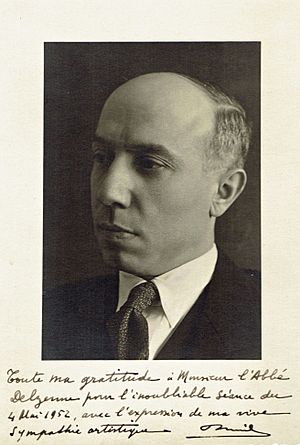Jean Absil facts for kids
Jean Absil (born October 23, 1893 – died February 2, 1974) was a famous Belgian composer. He also played the organ and taught music at the Brussels Conservatoire.
Contents
Biography: The Life of Jean Absil
Absil was born in Bonsecours, a town in Hainaut, Belgium. His first music teacher was Alphonse Oeyen, who was an organist at the local church. From 1913, Absil studied the organ and harmony at the Brussels Conservatoire. After finishing his studies, he decided to focus on writing music instead of just playing it.
In 1922, Absil won the Belgian Prix de Rome. This was a very important prize for young artists. In 1934, he won the Prix Rubens, which allowed him to travel to Paris. There, he met other modern composers like Ibert, Milhaud, and Honegger. Absil became well-known around the world when his first piano concerto (a piece for a solo instrument and orchestra) was played for the first time. This happened at the 1938 Queen Elizabeth Competition for Piano. It was a required piece for all the finalists. Only one pianist, Moura Lympany, played it perfectly from memory.
From 1930, Absil taught harmony at the Brussels Conservatoire. Six years later, he became a professor of counterpoint (a way of writing music with multiple independent melodies). One of his students was Paul Danblon. Absil also taught at the Chapelle Musicale Reine Elisabeth and the Etterbeek Music School. He helped start and edit a music magazine called Revue Internationale de Musique. In 1955, he became a member of Belgium's Royal Academy. He passed away in Brussels when he was 80 years old.
Compositions: Absil's Musical Style
At first, Absil's music sounded like the late Romantic style. He was especially influenced by composers like Wagner and Richard Strauss. But around 1934, when he visited Paris, his style started to change. He began using more modern techniques in his music. This included polyphony (music with several independent melodies playing at once) and polymodal structures (using different musical scales at the same time). He was inspired by modern composers like Milhaud and Schoenberg.
Even with his modern style, Absil's music always sounds clear and organized. While he didn't always use traditional major or minor scales, he created new musical modes for each piece. These new modes helped him create chords that still had a clear feeling of tension or release. Absil never wrote music that was completely atonal (without a clear musical key). His different musical lines always came together to create a sense of a main key.
Absil wrote a lot of music throughout his life, from his 20s until his late 70s. He especially focused on writing pieces for the piano because he was a skilled pianist himself. Some of his piano works include Ballade, op. 129, which is played only with the left hand. He also wrote 3 Pièces that are played only with the right hand.
For two-handed piano, he composed three sonatinas (smaller sonatas) and two Grand Suites. The Grand Suites (Op.110, from 1965) were a tribute to the famous composer Frédéric Chopin. In 1946, he wrote Hommage à Schumann, and in 1957, the Passacaglia in Memoriam Alban Berg, both for piano. His very last completed work was the Piano Concerto no. 3, op. 162.
Besides piano music, Absil also wrote an opera called Les Voix de la mer. He composed five symphonies (large musical pieces for orchestra). His first symphony (op. 1) was written when he was 27 and still a student of Paul Gilson. It won the Prix Agniez in 1921.
Images for kids
See also
 In Spanish: Jean Absil para niños
In Spanish: Jean Absil para niños





